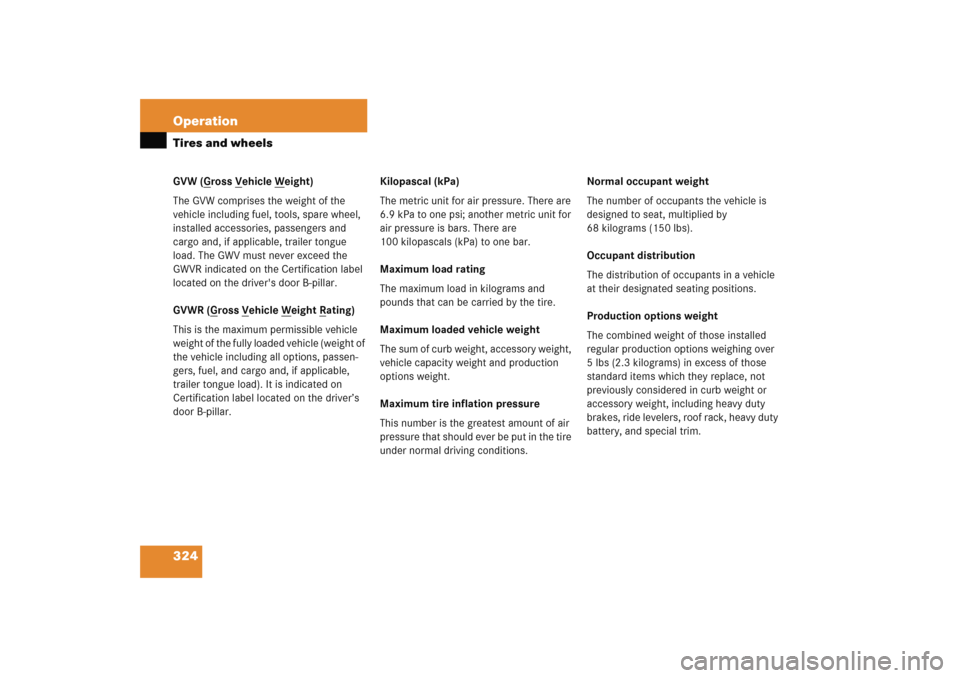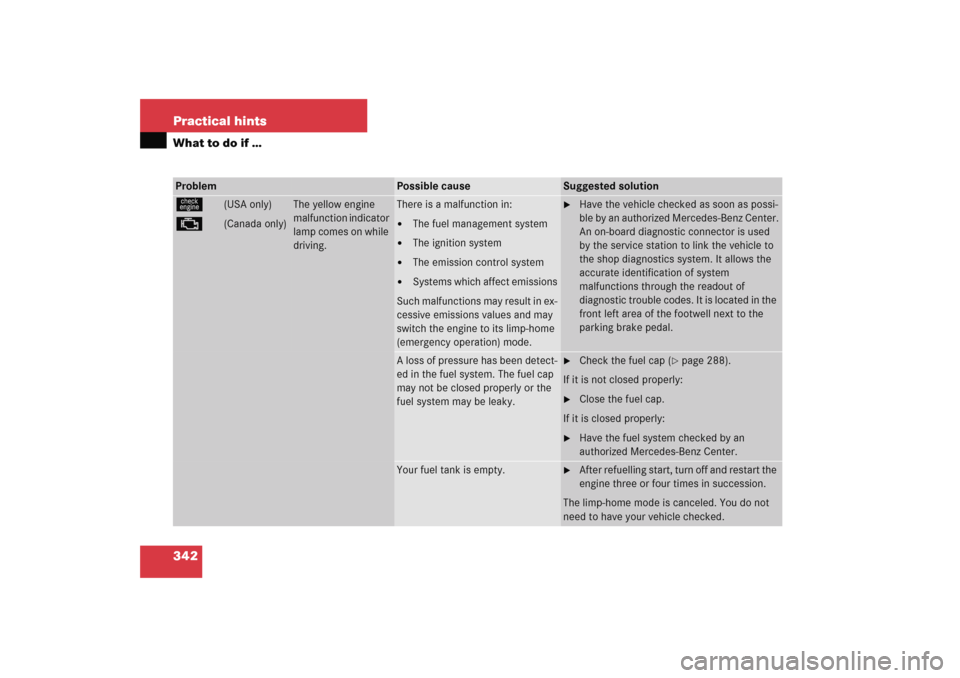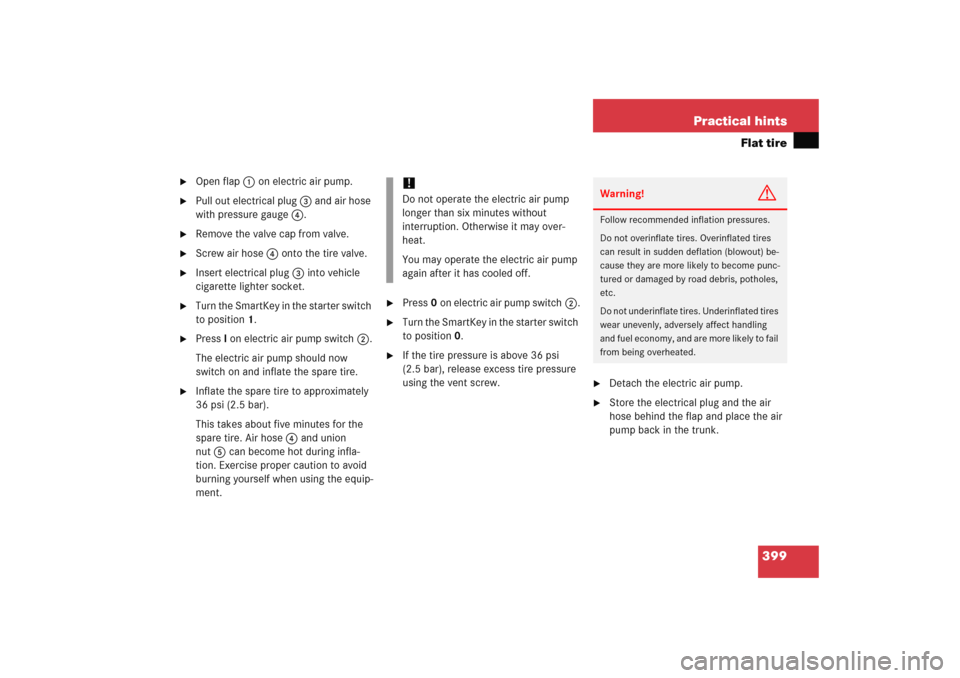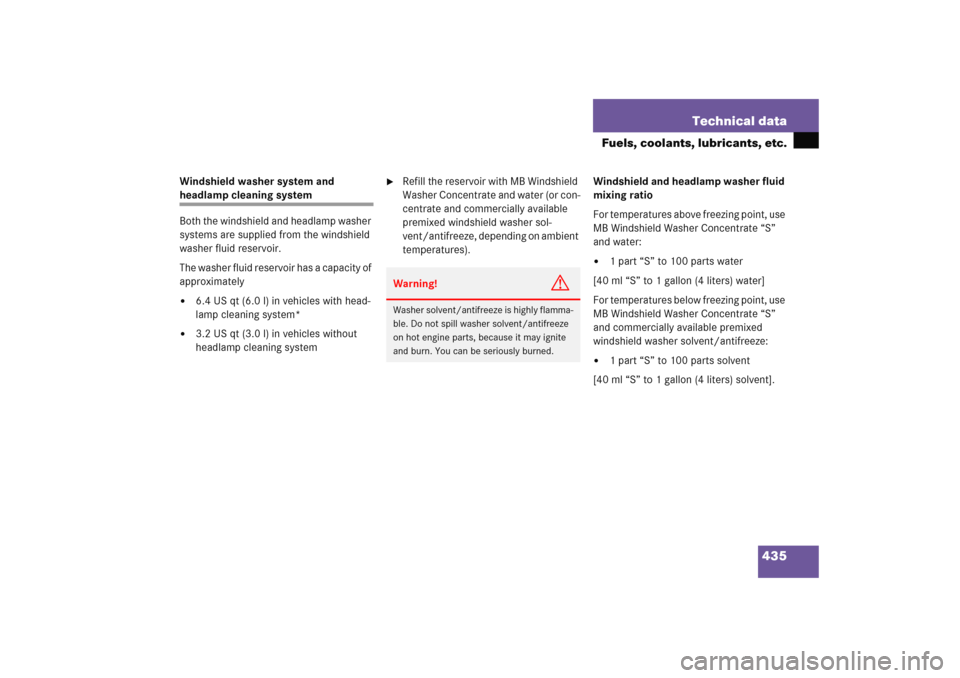Page 325 of 474

324 OperationTires and wheelsGVW (G
ross V
ehicle W
eight)
The GVW comprises the weight of the
vehicle including fuel, tools, spare wheel,
installed accessories, passengers and
cargo and, if applicable, trailer tongue
load. The GWV must never exceed the
GWVR indicated on the Certification label
located on the driver's door B-pillar.
GVWR (G
ross V
ehicle W
eight R
ating)
This is the maximum permissible vehicle
weight of the fully loaded vehicle (weight of
the vehicle including all options, passen-
gers, fuel, and cargo and, if applicable,
trailer tongue load). It is indicated on
Certification label located on the driver’s
door B-pillar.Kilopascal (kPa)
The metric unit for air pressure. There are
6.9 kPa to one psi; another metric unit for
air pressure is bars. There are
100 kilopascals (kPa) to one bar.
Maximum load rating
The maximum load in kilograms and
pounds that can be carried by the tire.
Maximum loaded vehicle weight
The sum of curb weight, accessory weight,
vehicle capacity weight and production
options weight.
Maximum tire inflation pressure
This number is the greatest amount of air
pressure that should ever be put in the tire
under normal driving conditions.Normal occupant weight
The number of occupants the vehicle is
designed to seat, multiplied by
68 kilograms (150 lbs).
Occupant distribution
The distribution of occupants in a vehicle
at their designated seating positions.
Production options weight
The combined weight of those installed
regular production options weighing over
5 lbs (2.3 kilograms) in excess of those
standard items which they replace, not
previously considered in curb weight or
accessory weight, including heavy duty
brakes, ride levelers, roof rack, heavy duty
battery, and special trim.
Page 343 of 474

342 Practical hintsWhat to do if …Problem
Possible cause
Suggested solution
ú
(USA only)
±
(Canada only)
The yellow engine
malfunction indicator
lamp comes on while
driving.
There is a malfunction in:�
The fuel management system
�
The ignition system
�
The emission control system
�
Systems which affect emissions
Such malfunctions may result in ex-
cessive emissions values and may
switch the engine to its limp-home
(emergency operation) mode.
�
Have the vehicle checked as soon as possi-
ble by an authorized Mercedes-Benz Center.
An on-board diagnostic connector is used
by the service station to link the vehicle to
the shop diagnostics system. It allows the
accurate identification of system
malfunctions through the readout of
diagnostic trouble codes. It is located in the
front left area of the footwell next to the
parking brake pedal.
A loss of pressure has been detect-
ed in the fuel system. The fuel cap
may not be closed properly or the
fuel system may be leaky.
�
Check the fuel cap (
�page 288).
If it is not closed properly:
�
Close the fuel cap.
If it is closed properly:
�
Have the fuel system checked by an
authorized Mercedes-Benz Center.
Your fuel tank is empty.
�
After refuelling start, turn off and restart the
engine three or four times in succession.
The limp-home mode is canceled. You do not
need to have your vehicle checked.
Page 366 of 474
365 Practical hints
What to do if …
Display symbol
Display message
Possible cause
Possible solution
4
Check gas cap.
See Operator’s Manual
A loss of pressure has been detected in
the fuel system. The fuel cap may not be
closed properly or the fuel system may be
leaky.
�
Check the fuel cap (
�page 288).
If it is not closed properly:
�
Close the fuel cap.
If it is closed properly:
�
Have the fuel system checked by an
authorized Mercedes-Benz Center.
Y
Hood open
You are driving with the hood open.
�
Close the hood (
�page 292).
I
Remove key.
You have forgotten to remove the
SmartKey.
�
Remove the SmartKey from the starter
switch.
Replace key
Drive to workshop
No additional code available for SmartKey.
�
Change the SmartKey.
Page 400 of 474

399 Practical hints
Flat tire
�
Open flap1 on electric air pump.
�
Pull out electrical plug3 and air hose
with pressure gauge4.
�
Remove the valve cap from valve.
�
Screw air hose4 onto the tire valve.
�
Insert electrical plug3 into vehicle
cigarette lighter socket.
�
Turn the SmartKey in the starter switch
to position1.
�
Press I on electric air pump switch 2.
The electric air pump should now
switch on and inflate the spare tire.
�
Inflate the spare tire to approximately
36 psi (2.5 bar).
This takes about five minutes for the
spare tire. Air hose4 and union
nut5 can become hot during infla-
tion. Exercise proper caution to avoid
burning yourself when using the equip-
ment.
�
Press0on electric air pump switch2.
�
Turn the SmartKey in the starter switch
to position0.
�
If the tire pressure is above 36 psi
(2.5 bar), release excess tire pressure
using the vent screw.
�
Detach the electric air pump.
�
Store the electrical plug and the air
hose behind the flap and place the air
pump back in the trunk.
!Do not operate the electric air pump
longer than six minutes without
interruption. Otherwise it may over-
heat.
You may operate the electric air pump
again after it has cooled off.
Warning!
G
Follow recommended inflation pressures.
Do not overinflate tires. Overinflated tires
can result in sudden deflation (blowout) be-
cause they are more likely to become punc-
tured or damaged by road debris, potholes,
etc.
Do not underinflate tires. Underinflated tires
wear unevenly, adversely affect handling
and fuel economy, and are more likely to fail
from being overheated.
Page 427 of 474
426 Technical dataFuels, coolants, lubricants, etc.CapacitiesVehicle components and their respective
lubricants must match. Therefore use only
brands tested and approved by
Mercedes-Benz. Please refer to the Factory Approved Service Products
pamphlet, or inquire at your authorized
Mercedes-Benz Center.
Model
Capacity
Fuels, coolants, lubricants, etc.
Engine with oil filter
C230Kompressor
C320
5.8 US qt (5.5 l)
7.9 US qt (7.5 l)
approved engine oils
Automatic transmission
8.5 US qt (8.0 l)
MB Automatic Transmission Fluid
Manual transmission
1.3 US qt (1.2 l)
MB Manual Transmission Oil
Rear axle
1.2 US qt (1.1 l)
Hypoid gear oil SAE 85 W 90
Power steering
approx. 1.1 US qt (1.0 l)
MB Power Steering Fluid (Pentosin CHF 11S)
Front wheel hubs
approx. 2.1 oz (60 g) each
High temperature roller bearing grease
Cooling system
C230Kompressor
C320
approx. 5.9 US qt (5.6 l)
approx. 6.8 US qt (6.4 l)
MB 325.0 Anticorrosion/Antifreeze Agent
Page 428 of 474
427 Technical data
Fuels, coolants, lubricants, etc.
Model
Capacity
Fuels, coolants, lubricants, etc.
Fuel tank
including a reserve of
16.4 US gal (62.0 l)
2.1 US gal (8.0 l)
Premium unleaded gasoline:
Minimum Posted Octane 91 (Avg. of 96 RON / 86 MON)
Flexible Fuel Vehicles (identified by a label reading
Premium gasoline or E85 only! on fuel filler flap):
Alternative fuel: Ethanol fuel (E85)
Air conditioning system
R-134a refrigerant and special PAG lubricant oil
(never R-12)
Windshield washer
3.2 US qt (3.0 l)
MB Windshield Washer Concentrate
1
Windshield washer and
headlamp cleaning system*
6.4 US qt (6.0 l)
1Use MB Windshield Washer Concentrate “S” and water for temperatures above freezing point or MB Windshield Washer Concentrate “S” and commercially available
premixed windshield washer solvent/antifreeze for temperatures below freezing point. Follow suggested mixing ratios (�page 435).
Page 434 of 474
![MERCEDES-BENZ C COUPE 2005 CL203 Owners Manual 433 Technical data
Fuels, coolants, lubricants, etc.
If you use a solution that is more than 55%
anticorrosion/antifreeze (freeze protec-
tion to approximately - 49°F [-45°C]), the
engine temperat MERCEDES-BENZ C COUPE 2005 CL203 Owners Manual 433 Technical data
Fuels, coolants, lubricants, etc.
If you use a solution that is more than 55%
anticorrosion/antifreeze (freeze protec-
tion to approximately - 49°F [-45°C]), the
engine temperat](/manual-img/4/3438/w960_3438-433.png)
433 Technical data
Fuels, coolants, lubricants, etc.
If you use a solution that is more than 55%
anticorrosion/antifreeze (freeze protec-
tion to approximately - 49°F [-45°C]), the
engine temperature will increase due to
the lower heat transfer capability of the so-
lution. Therefore, do not use more than
this amount of anticorrosion/antifreeze.
If the coolant level is low, water and
MB 325.0 anticorrosion/antifreeze should
be used to bring it up to the proper level
(have cooling system checked for signs of
leakage). Please make sure the mixture is
in accordance with label instructions.
The water in the cooling system must meet
minimum requirements, which are usually
satisfied by normal drinking water. If you
are not sure about the water quality, con-
sult an authorized Mercedes-Benz Center.Anticorrosion/antifreeze
Your vehicle contains a number of alumi-
num parts. The use of aluminum compo-
nents in motor vehicle engines
necessitates that anticorrosion/antifreeze
coolant used in such engines be specifical-
ly formulated to protect the aluminum
parts. (Failure to use such anticorro-
sion/antifreeze coolant will result in a
significantly shortened service life.)
Therefore, the following product is strongly
recommended for use in your vehicle:
Mercedes-Benz 325.0 Anticorrosion/Anti-
freeze agent.Before the start of the winter season (or
once a year in hot southern regions), you
should have the anticorrosion/antifreeze
concentration checked. The coolant is also
regularly checked each time you bring your
vehicle to an authorized Mercedes-Benz
Center for service.
Page 436 of 474

435 Technical data
Fuels, coolants, lubricants, etc.
Windshield washer system and headlamp cleaning system
Both the windshield and headlamp washer
systems are supplied from the windshield
washer fluid reservoir.
The washer fluid reservoir has a capacity of
approximately�
6.4 US qt (6.0 l) in vehicles with head-
lamp cleaning system*
�
3.2 US qt (3.0 l) in vehicles without
headlamp cleaning system
�
Refill the reservoir with MB Windshield
Washer Concentrate and water (or con-
centrate and commercially available
premixed windshield washer sol-
vent/antifreeze, depending on ambient
temperatures).Windshield and headlamp washer fluid
mixing ratio
For temperatures above freezing point, use
MB Windshield Washer Concentrate “S”
and water:
�
1 part “S” to 100 parts water
[40 ml “S” to 1 gallon (4 liters) water]
For temperatures below freezing point, use
MB Windshield Washer Concentrate “S”
and commercially available premixed
windshield washer solvent/antifreeze:
�
1 part “S” to 100 parts solvent
[40 ml “S” to 1 gallon (4 liters) solvent].
Warning!
G
Washer solvent/antifreeze is highly flamma-
ble. Do not spill washer solvent/antifreeze
on hot engine parts, because it may ignite
and burn. You can be seriously burned.